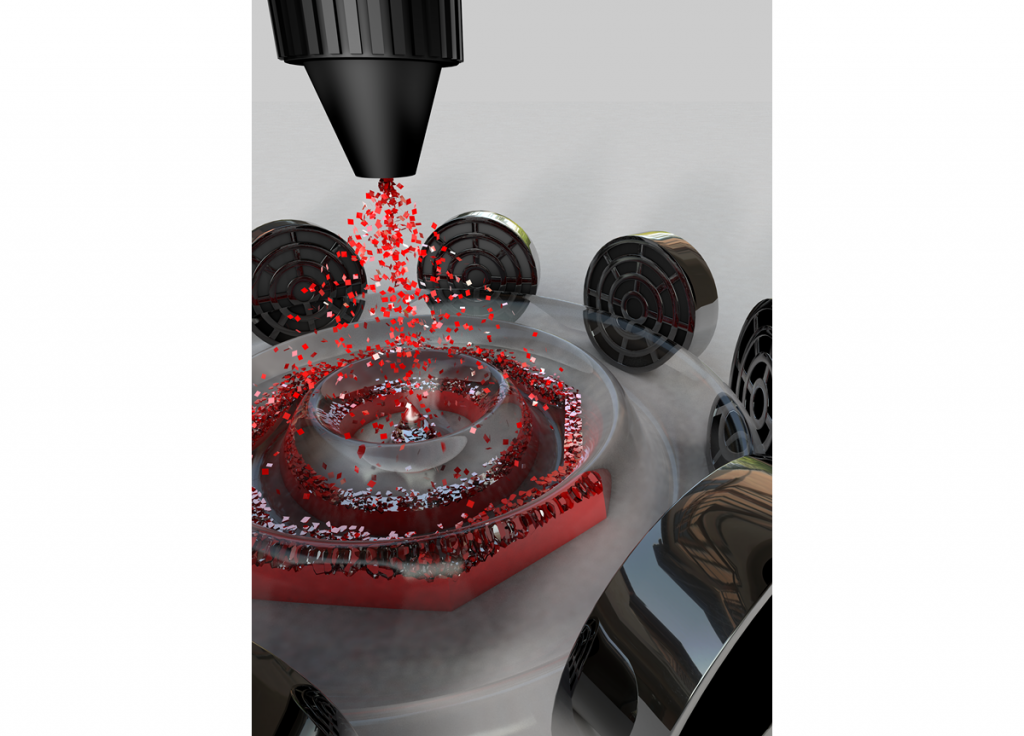A team of researchers from the University of Bath and the University of Bristol have developed a new 3D bioprinting technique that leverages acoustic energy.
Sonolithography, as it’s called, uses computer-controlled ultrasound waves to precisely deposit particles and droplets into predetermined patterns on a substrate. The ability to control aerosol sprays in a non-contact manner lends itself to a whole host of biofabrication and tissue engineering applications, as well as complex drug delivery and even wound healing.
Jenna Shapiro, lead author of the study, explains, “Sonolithography enables gentle, non-contact and rapid patterning of cells and biomaterials on surfaces. Tissue engineering can use biofabrication methods to build defined structures of cells and materials. We are adding a new technique to the biofabrication toolbox.”

Ultrasound and particle manipulation
The use of ultrasound in microparticle manipulation is not a new concept, and the technique has previously been shown to levitate small objects with stable results. A great application of the technology is in spectroscopy, whereby fluids are characterized based on the wavelengths of light they absorb and reflect.
Taking a droplet of blood as an example, characterizing a sample on a solid substrate will no doubt skew the results due a mixing of light from both the blood and the substrate below. In a case like this, levitation can isolate the blood, ensuring a more accurate result by eliminating unwanted ‘noise’.
The UK scientists took this idea a step further, adding an element of directionality to the levitation functionality. By superimposing several ultrasonic standing waves, the team was able to generate controllable acoustic radiation forces to direct airborne droplets to accumulate into precise pools.
Looking at the results, the team successfully demonstrated sonolithography in the 5 – 20 micron (particle size) range – a scale at which even the most sophisticated physical sorting techniques would struggle. The approach also grants a great deal of material flexibility, both in terms of the deposit and the substrate below. As well as general aerosols, sonolithography was found to be compatible with highlighter inks, sand, proteins and even entire mammalian cells.

What’s next for sonolithography?
Shapiro’s research team intends to develop the process further by introducing dynamic control into the mix, which would allow for real-time manipulation of the acoustic field. In the context of biofabrication, this would enable unique biomaterial microarchitectures to be produced and modified on the fly. The team has also stated that the 3D bioprinting of mammalian soft tissues for modeling and regenerative medicine purposes is of particular interest to them.
Going beyond the biological applications, sonolithography may also see use in the printing of electronics, using conductive nano inks for circuit connections. In the realm of industrial processes, the technique may also enable precision painting and spray coating applications.
Further details of the study can be found in the paper titled ‘Sonolithography: In‐Air Ultrasonic Particulate and Droplet Manipulation for Multiscale Surface Patterning’. It is co-authored by Jenna Shapiro et al.
Ultrasonic waves have proven to be a very useful general-purpose tool across multiple areas of 3D printing. Late last year, biotechnology company mimiX Biotherapeutics announced the launch of its own acoustic bioprinter called cymatiX. Much like the Bristol device, cymatiX uses ultrasonic waves to pattern and condense living cells via resonance, enabling users to “orchestrate life with sound”.
In the industrial space, ultrasound is also used for post-processing applications. Back in 2020, automated post-printing system manufacturer PostProcess Technologies announced the launch of Variable Acoustic Displacement (VAD), the company’s fifth technology family. VAD uses acoustic energy to non-destructively remove loose powder from 3D printed polymer parts.
Subscribe to the 3D Printing Industry newsletter for the latest news in additive manufacturing. You can also stay connected by following us on Twitter and liking us on Facebook.
Looking for a career in additive manufacturing? Visit 3D Printing Jobs for a selection of roles in the industry.
Featured image shows the sonolithography process. Image via Uni of Bristol.



